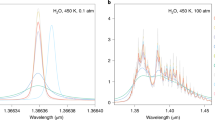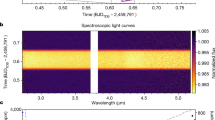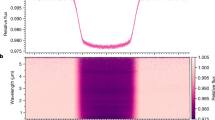Abstract
Exoplanets are now being discovered in profusion. To understand their character, however, we require spectral models and data. These elements of remote sensing can yield temperatures, compositions and even weather patterns, but only if significant improvements in both the parameter retrieval process and measurements are made. Despite heroic efforts to garner constraining data on exoplanet atmospheres and dynamics, reliable interpretation has frequently lagged behind ambition. I summarize the most productive, and at times novel, methods used to probe exoplanet atmospheres; highlight some of the most interesting results obtained; and suggest various broad theoretical topics in which further work could pay significant dividends.
This is a preview of subscription content, access via your institution
Access options
Subscribe to this journal
Receive 51 print issues and online access
$199.00 per year
only $3.90 per issue
Buy this article
- Purchase on Springer Link
- Instant access to full article PDF
Prices may be subject to local taxes which are calculated during checkout





Similar content being viewed by others
References
Mayor, M. & Queloz, D. A Jupiter-mass companion to a solar-type star. Nature 378, 355–359 (1995). This discovery paper inaugurated the modern era of exoplanet research.
Charbonneau, D., Brown, T., Latham, D. W. & Mayor, M. Detection of planetary transits across a Sun-like star. Astrophys. J. 529, L45–L48 (2000).
Borucki, W. J. et al. Kepler planet-detection mission: introduction and first results. Science 327, 977–980 (2010).
Moutou, C. et al. CoRoT: Harvest of the exoplanet program. Icarus 226, 1625–1634 (2013).
Burrows, A. S. Spectra as windows into exoplanet atmospheres. Proc. Natl Acad. Sci. USA http://dx.doi.org/10.1073/pnas.1304208111 (2014) This paper provides an unvarnished appraisal of current state-of-the-art exoplanet atmosphere characterization.
Brown, T. Transmission spectra as diagnostics of extrasolar giant planet atmospheres. Astrophys. J. 553, 1006–1026 (2001).
Seager, S. & Sasselov, D. D. Theoretical transmission spectra during extrasolar giant planet transits. Astrophys. J. 537, 916–921 (2000).
Fortney, J. J. et al. On the indirect detection of sodium in the atmosphere of the transiting planet HD209458b. Astrophys. J. 589, 615–622 (2003).
Werner, M. W. et al. The Spitzer Space Telescope mission. Astrophys. J. 154 (Suppl.), 1–9 (2004).
Macintosh, B. et al. The Gemini Planet Imager: from science to design to construction. Proc. SPIE 7015, 701518 (2008).
Beuzit, J.-L. et al. SPHERE: a planet finder instrument for the VLT. Proc. SPIE 7014, 701418 (2008).
Suzuki, R. et al. Performance characterization of the HiCIAO instrument for the Subaru Telescope. Proc. SPIE 7735, 773530 (2010).
Spergel, D. N. et al. Wide-field infrared survey telescope – astrophysics focused telescope assets WFIRST-AFTA final report. Preprint at http://arxiv.org/abs/1305.5422 (2013).
Madhusudhan, N., Knutson, H., Fortney, J. J. & Barman, T. Exoplanetary atmospheres. Preprint at http://arXiv.org/abs/1402.1169 (2014).
Burrows, A. & Orton, G. in Exoplanets (ed. Seager, S.) 419–440 (Univ. Arizona Press, 2010).
Fletcher, L. N. et al. Exploring the diversity of Jupiter-class planets. Phil. Trans. R. Soc. A 372, 20130064 (2014).
Tinetti, G. Galactic planetary science. Preprint at http://arXiv.org/abs/1402.1085 (2014).
Tinetti, G. et al. in Proc. Inter. Astronom. Union IAU Symposium 6 (S276) 359–370 (2011).
Guillot, T. On the radiative equilibrium of irradiated planetary atmospheres. Astron. Astrophys. 520, A27–A39 (2010).
Burrows, A., Hubbard, W. B. & Lunine, J. I. The theory of brown dwarfs and extrasolar giant planets. Rev. Mod. Phys. 73, 719–765 (2001).
Burrows, A. et al. A nongray theory of extrasolar giant planets and brown dwarfs. Astrophys. J. 491, 856–875 (1997).
Deming, D. et al. Discovery and characterization of transiting super Earths using an all-sky transit survey and follow-up by the James Webb Space Telescope. Publ. Astron. Soc. Pac. 121, 952–967 (2009).
Rothman, L. S. et al. The HITRAN 2008 molecular spectroscopic database. J. Quant. Spectrosc. Radiat. Transf. 110, 533–572 (2009).
Tennyson, J. & Yurchenko, S. N. The status of spectroscopic data for the exoplanet characterisation missions. Preprint at http://arXiv.org/abs/1401.4212 (2014).
Hill, C., Yurchenko, S. N. & Tennyson, J. Temperature-dependent molecular absorption cross sections for exoplanets and other atmospheres. Icarus 226, 1673–1677 (2013).
Freedman, R. S., Marley, M. S. & Lodders, K. Line and mean opacities for ultracool dwarfs and extrasolar planets. Astrophys. J. 174 (Suppl.), 504–513 (2008).
Sharp, C. M. & Burrows, A. Atomic and molecular opacities for brown dwarf and giant planet atmospheres. Astrophys. J. 168 (Suppl.), 140–166 (2007).
Lodders, K. Solar System abundances and condensation temperatures of the elements. Astrophys. J. 591, 1220–1247 (2003).
Lodders, K. & Fegley, B. Atmospheric chemistry in giant planets, brown dwarfs, and low-mass dwarf stars. I. Carbon, nitrogen, and oxygen. Icarus 155, 393–424 (2002).
Lodders, K. & Fegley, B. The Planetary Scientist's Companion (Oxford Univ. Press, 1998).
Burrows, A. & Sharp, C. Chemical equilibrium abundances in brown dwarf and extrasolar giant planet atmospheres. Astrophys. J. 512, 843–863 (1999).
Schaefer, L. & Fegley, B. Chemistry of silicate atmospheres of evaporating super-Earths. Astrophys. J. 703, L113–L117 (2009).
Lecavelier des Etangs, A., Pont, F., Vidal-Madjar, A. & Sing, D. Rayleigh scattering in the transit spectrum of HD 189733b. Astron. Astrophys. 481, L83–L86 (2008).
Charbonneau, D., Brown, T., Noyes, R. W. & Gilliland, R. L. Detection of an extrasolar planet atmosphere. Astrophys. J. 568, 377–384 (2002). This paper announced the first ever detection of a specific chemical species (sodium) in an exoplanet atmosphere.
Sing, D. K. et al. Gran Telescopio Canarias OSIRIS transiting exoplanet atmospheric survey: detection of potassium in XO-2b from narrowband spectrophotometry. Astron. Astrophys. 527, 10 (2011).
Pont, F. et al. The prevalence of dust on the exoplanet HD 189733b from Hubble and Spitzer observations. Mon. Not. R. Astron. Soc. 432, 2917–2944 (2013). This paper is the most definitive study at primary transit pointing to the potential centrality of obscuring hazes in an exoplanet atmosphere.
Pont, F., Knutson, H. A., Gilliland, R. L. M. & Charbonneau D. Detection of atmospheric haze on an extrasolar planet: the 0.55–1.05 μ transmission spectrum of HD 189733b with the Hubble Space Telescope. Mon. Not. R. Astron. Soc. 385, 109–118 (2008).
Burrows, A., Marley, M. M. & Sharp, C. M. The near-infrared and optical spectra of methane dwarfs and brown dwarfs. Astrophys. J. 531, 438–446 (2000).
Grillmair, C. J. et al. Strong water absorption in the dayside emission spectrum of the planet HD189733b. Nature 456, 767–769 (2008).
Howe, A. & Burrows, A. Theoretical transit spectra for GJ 1214b and other 'super-Earths'. Astrophys. J. 756, 176–189 (2012).
Kreidberg, L. et al. Clouds in the atmosphere of the super-Earth exoplanet GJ1214b. Nature 505, 69–72 (2014).
Deming, D. et al. Infrared transmission spectroscopy of the exoplanets HD 209458b and XO-1b using the Wide-Field Camera-3 on the Hubble Space Telescope. Astrophys. J. 774, 95–112 (2013).
Marley, M. S., Ackerman, A. S., Cuzzi, J. N. & Kitzmann, D. in Comparative Climatology of Terrestrial Planets (eds Mackwell, S., Bullock, M. & Harder, J.) 367–391 (Univ. Arizona Press, 2013).
Showman, A. P. et al. Atmospheric circulation of hot Jupiters: coupled radiative-dynamical general circulation model simulations of HD 189733b and HD 209458b. Astrophys. J. 699, 564–584 (2009).
Deming, D., Seager, S., Richardson, L. J. & Harrington, J. Infrared radiation from an extrasolar planet. Nature 434, 740–743 (2005). This paper was the first to demonstrate the potential of the Spitzer Space Telescope to measure the light of an exoplanet during secondary eclipse.
Charbonneau, D. et al. Detection of thermal emission from an extrasolar planet. Astrophys. J. 626, 523–529 (2005).
Burrows, A., Hubeny, I. & Sudarsky, D. A theoretical interpretation of the measurements of the secondary eclipses of TrES-1 and HD 209458b. Astrophys. J. 625, L135–L138 (2005).
Burrows, A. & Lunine, J. Astronomical questions of origins and survival. Nature 378, 333 (1995).
Vidal-Madjar, A. et al. An extended upper atmosphere around the extrasolar planet HD209458b. Nature 422, 143–146 (2003). This paper was the first to discover signatures of winds emanating from exoplanets.
Lecavelier Des Etangs, A. et al. Evaporation of the planet HD 189733b observed in H I Lyman-á. Astrophys. Astron. 514, 10 (2010)
Fossati, L. et al. Metals in the exosphere of the highly irradiated planet WASP-12b. Astrophys. J. 714, L222–L227 (2010).
Kulow, J. R., France, K., Linsky, J. & Parke Loyd, R. O. Lyman-α transit spectroscopy and the neutral hydrogen tail of the hot Neptune GJ 436b. Preprint at http://arXiv.org/abs/1403.6834 (2014).
Ehrenreich, D. & Désert, J.-M. Mass-loss rates for transiting exoplanets. Astron. Astrophys. 529, A136 (2011).
Linsky, J. L. et al. Observations of mass loss from the transiting exoplanet HD 209458b. Astrophys. J. 717, 1291–1299 (2010).
Marley, M. S., Gelino, C., Stephens, D., Lunine, J. I. & Freedman, R. Reflected spectra and albedos of extrasolar giant planets. I. Clear and cloudy atmospheres. Astrophys. J. 513, 879–893 (1999).
Sudarsky, D., Burrows, A. & Pinto, P. Albedo and reflection spectra of extrasolar giant planets. Astrophys. J. 538, 885–903 (2000). This paper provides a comprehensive theory of the reflection and albedo spectra of giant exoplanets as a function of orbital distance and planet mass.
Burrows, A., Sudarsky, D. & Hubeny, I. Spectra and diagnostics for the direct detection of wide-separation extrasolar giant planets. Astrophys. J. 609, 407–416 (2004).
Barman, T. S., Hauschildt, P. H. & Allard, F. Phase-dependent properties of extrasolar planet atmospheres. Astrophys. J. 632, 1132–1139 (2005).
Madhusudhan, N. & Burrows, A. Analytic models for albedos, phase curves, and polarization of reflected light from exoplanets. Astrophys. J. 747, 25–40 (2012).
Esteves, L. J., De Mooij, E. J. W. & Jayawardhana, R. Optical phase curves of Kepler exoplanets. Astrophys. J. 772, 51–64 (2013).
Rowe, J. et al. The very low albedo of an extrasolar planet: MOST space-based photometry of HD 209458. Astrophys. J. 689, 1345–1353 (2008).
Burrows, A., Ibgui, L. & Hubeny, I. Optical albedo theory of strongly-irradiated giant planets: the case of HD 209458b. Astrophys. J. 682, 1277–1282 (2008).
Knutson, H. A. et al. A map of the day-night contrast of the extrasolar planet HD 189733b. Nature 447, 183–186 (2007). Using one of the first exoplanet light curves, this paper determined a crude surface temperature map of an exoplanet.
Knutson, H. A. et al. 3.6 and 4.6 μ phase curves and evidence for non-equilibrium chemistry in the atmosphere of extrasolar planet HD 189733b. Astrophys. J. 754, 22–37 (2012).
Majeau, C., Agol, E. & Cowan, N. B. A. Two-dimensional map of the extrasolar planet HD 189733b. Astrophys. J. 747, L20–L24 (2012).
Knutson, H. A. et al. The 8 μ phase variation of the hot Saturn HD 149026b. Astrophys. J. 703, 769–784 (2009).
Lewis, N. K. et al. Orbital phase variations of the eccentric giant planet HAT-P-2b. Astrophys. J. 766, 95–117 (2013).
Cowan, N. B. et al. Thermal phase variations of WASP-12b: defying predictions. Astrophys. J. 747, 82–98 (2012).
Crossfield, I. J. M. et al. A new 24 μ phase curve for υ Andromedae b. Astrophys. J. 723, 1436–1446 (2010).
Seager, S., Whitney, B. A. & Sasselov, D. D. Photometric light curves and polarization of close-in extrasolar giant planets. Astrophys. J. 540, 504–520 (2000).
Snellen, I. A. G., de Kok, R. J., de Mooij, E. J. W. & Albrecht, S. The orbital motion, absolute mass and high-altitude winds of exoplanet HD 209458b. Nature 465, 1049–1051 (2010).
de Kok, R., et al. Detection of carbon monoxide in the high-resolution day-side spectrum of the exoplanet HD 189733b. Astron. Astrophys. 554, A82 (2013).
Birkby, J. et al. Detection of water absorption in the day side atmosphere of HD 189733b using ground-based high-resolution spectroscopy at 3.2 μ. Mon. Not. R. Astron. Soc. 436, L35–L39 (2013).
Brogi, M. et al. The signature of orbital motion from the dayside of the planet τ Boötes b. Nature 486, 502–504 (2012).
Snellen, I. A. G. et al. The fast spin-rotation of the young extra-solar planet β Pictoris b. Nature 509, 63–65 (2014).
Crossfield, I. J. M. et al. A global cloud map of the nearest known brown dwarf. Nature 505, 654–656 (2014).
Burrows, A. A theoretical look at the direct detection of giant planets outside the Solar System. Nature 433, 261–268 (2005).
Marois, C. et al. Direct imaging of multiple planets orbiting the star HR 8799. Science 322, 1348–1352 (2008). This paper represents the coming of age of the direct, high-contrast imaging technique of exoplanet discovery and characterization.
Marois, C., Zuckerman, B., Konopacky, Q. M., Macintosh, B. & Barman, T. Images of a fourth planet orbiting HR 8799. Nature 468, 1080–1083 (2010).
Lagrange, A. M. et al. A probable giant planet imaged in the β Pictoris disk. VLT/NaCo deep L'-band imaging. Astron. Astrophys. 493, L21–L25 (2009).
Madhusudhan, N., Burrows, A. & Currie, T. Model atmospheres for massive gas giants with thick clouds: application to the HR 8799 planets. Astrophys. J. 737, 34–48 (2011).
Konopacky, Q. M., Barman, T. S., Macintosh, B. A. & Marois, C. Detection of carbon monoxide and water absorption lines in an exoplanet atmosphere. Science 339, 1398–1401 (2013).
Kaltenegger, L., Traub, W. A. & Jucks, K. W. Spectral evolution of an Earth-like planet. Astrophys. J. 658, 598–616 (2007).
Ehrenreich, D., Tinetti, G., Lecavelier Des Etangs, A., Vidal-Madjar, A. & Selsis, F. The transmission spectrum of Earth-size transiting planets. Astron. Astrophys. 448, 379–393 (2006).
Acknowledgements
The author acknowledges support in part under Hubble Space Telescope grants HST-GO-12181.04-A, HST-GO-12314.03-A, HST-GO-12473.06-A, and HST-GO-12550.02 and Jet Propulsion Laboratory/Spitzer Agreements 1417122, 1348668, 1371432, 1377197 and 1439064.
Author information
Authors and Affiliations
Corresponding author
Ethics declarations
Competing interests
The author declares no competing financial interests.
Additional information
Reprints and permissions information is available at www.nature.com/reprints.
Rights and permissions
About this article
Cite this article
Burrows, A. Highlights in the study of exoplanet atmospheres. Nature 513, 345–352 (2014). https://doi.org/10.1038/nature13782
Received:
Accepted:
Published:
Issue Date:
DOI: https://doi.org/10.1038/nature13782
This article is cited by
-
Beyond Hubble
Nature Chemistry (2022)
-
The impending opacity challenge in exoplanet atmospheric characterization
Nature Astronomy (2022)
-
Cavity buildup dispersion spectroscopy
Communications Physics (2021)
-
Atmospheric Dynamics of Hot Giant Planets and Brown Dwarfs
Space Science Reviews (2020)
-
A map of the large day–night temperature gradient of a super-Earth exoplanet
Nature (2016)
Comments
By submitting a comment you agree to abide by our Terms and Community Guidelines. If you find something abusive or that does not comply with our terms or guidelines please flag it as inappropriate.



